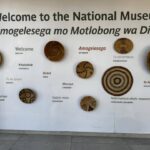Botswana is quietly positioning itself as a strong contender in Africa’s textile and fashion manufacturing space. With an abundance of raw materials like high-quality cotton and genuine leather, the country has the potential to create a thriving textile industry that not only fuels local economic growth but also competes on the global stage. By investing in homegrown manufacturing, Botswana can turn its natural resources into high-value products while creating jobs and empowering local entrepreneurs.
The country already grows cotton, particularly in the eastern regions where smallholder farmers cultivate it for both domestic use and export. Yet much of this cotton is still shipped abroad for processing, which limits the potential economic benefits that could be captured through value addition. Similarly, Botswana’s leather industry—supported by a well-established beef sector—produces some of the finest hides on the continent, but the processing and finishing of leather goods remain underdeveloped locally.
This creates a significant opportunity. Developing a textile manufacturing industry that uses Botswana’s cotton and leather would allow the country to move up the value chain. Instead of exporting raw cotton or untreated hides, Botswana could be producing fabrics, garments, shoes, bags, and accessories under its own national or regional brands. This shift would create employment in ginning, spinning, dyeing, tailoring, and leatherworking—skills that can be taught, scaled, and passed on to future generations.
Local manufacturing also supports the government’s broader economic diversification goals. As Botswana looks to reduce its reliance on diamond mining, sectors like agro-processing, textiles, and creative industries are gaining traction. Cotton and leather sit right at the intersection of agriculture, fashion, and manufacturing—making them ideal pillars for inclusive, sustainable industrial growth.
Furthermore, with the African Continental Free Trade Area (AfCFTA) in motion, Botswana-made textile products could access a much larger market with fewer trade barriers. This opens the door to regional exports of clothing and leather goods made from local materials, appealing to consumers who value quality, heritage, and authenticity. A strong “Made in Botswana” label can become a source of national pride and an economic engine.
To fully realise this potential, several factors need to align. Investments in processing facilities, technology upgrades, skills training, and creative design are essential. Public-private partnerships can play a crucial role in building industrial parks, offering incentives to manufacturers, and supporting fashion startups. In addition, Botswana’s creative community—fashion designers, artisans, and stylists—can drive demand for locally sourced and produced materials by incorporating them into contemporary designs that resonate with both local and international audiences.
Sustainability is another key advantage. With the world moving toward more eco-conscious consumption, Botswana has a chance to market its cotton and leather as ethically sourced and environmentally responsible. Supporting organic cotton farming, reducing waste in leather processing, and promoting circular fashion models can attract global buyers and conscious consumers.
Ultimately, textile manufacturing using Botswana’s cotton and leather is about more than just production—it’s about building an industry that reflects the country’s identity, supports its people, and tells a story of quality and authenticity. From raw material to finished product, Botswana can own its fashion narrative, create meaningful jobs, and proudly wear its label on the world stage.










